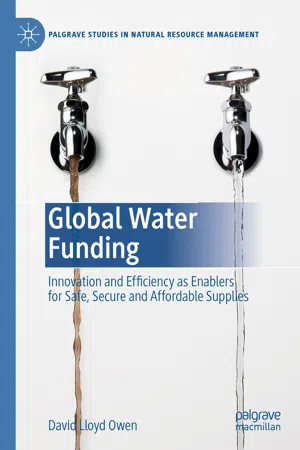
Global Water Funding
Innovation and efficiency as enablers for safe, secure and affordable supplies
- English
- ePUB (mobile friendly)
- Available on iOS & Android
Global Water Funding
Innovation and efficiency as enablers for safe, secure and affordable supplies
About this book
Is safe and sustainable water and sanitation for all an unaffordable pipedream? This book surveys the worldwide development of water and sewage services and the challenges in meeting Sustainable Development Goal 6 (SDG6) along with climate change, population growth and urbanisation. It explores the reasons why current SDG6 progress is failing, including weak policy implementation, staff shortages and inadequate funding, as well as the limited impact of aid funding. The author contends that despite a series of innovations, debt finance remains too small to address needs of developing economies. Therefore, instead of advocating new funding, this book proposes addressing the funding gap through technological innovation and more efficient management and procurement through a series of examples that have challenged traditional assumptions.
After four decades of good intentions, SDG6 is making a difference in monitoring shortfalls for the first time, allowing for more effective responses. This book outlines the role of innovation in hardware development, procurement and installation, and discusses how network management and operations can most effectively address funding gaps. The potential for savings is considerable, if effectively replicated. New approaches are driving forward affordable resilience, including nature-based solutions such as upstream habitat enhancement to retain water and improve downstream water quality; the circular economy, including water, nutrient, energy and heat recovery from wastewater; and demand management. This book will be of great value to scholars, policy makers and practitioners interested in the global finance of sustainable water and sanitation.
Frequently asked questions
- Essential is ideal for learners and professionals who enjoy exploring a wide range of subjects. Access the Essential Library with 800,000+ trusted titles and best-sellers across business, personal growth, and the humanities. Includes unlimited reading time and Standard Read Aloud voice.
- Complete: Perfect for advanced learners and researchers needing full, unrestricted access. Unlock 1.4M+ books across hundreds of subjects, including academic and specialized titles. The Complete Plan also includes advanced features like Premium Read Aloud and Research Assistant.
Please note we cannot support devices running on iOS 13 and Android 7 or earlier. Learn more about using the app.
Information
1. The Case for Universal and Sustainable Access
Table of contents
- Cover
- Front Matter
- 1. The Case for Universal and Sustainable Access
- 2. Where We Are
- 3. Where We Need to Be
- 4. The Costs Involved
- 5. Funding Flows Today
- 6. The Gap Between Aspirations and Realities
- 7. Addressing Capital Costs
- 8. Lowering Operating Costs
- 9. Demand Management and Resource Recovery
- 10. Innovation, Efficiency and Affordability
- Back Matter